Eternal figure of the Renaissance, Leonardo da Vinci remains a source of inspiration, 500 years after his death. Let’s discover Italy today differently, following in the footsteps of Italian genius.
Summary
- The province of Vinci
- Florence, the decisive formation
- The Milanese years
- Leonardo, at the top of his game
Man of universal spirit, creative genius, painter, sculptor, engineer, philosopher… Adjectives, like activities, are not lacking to paint the portrait of the character of Leonardo da Vinci. And if he is a figure, perhaps THE great figure of the Renaissance, he is also the face of an Italy full of fascination.
Through this article, we invite you to discover the Italian lands from a new angle. A mixture of history and landscapes, which will make you travel both in time and in the most beautiful cities of Italy.
The province of Vinci
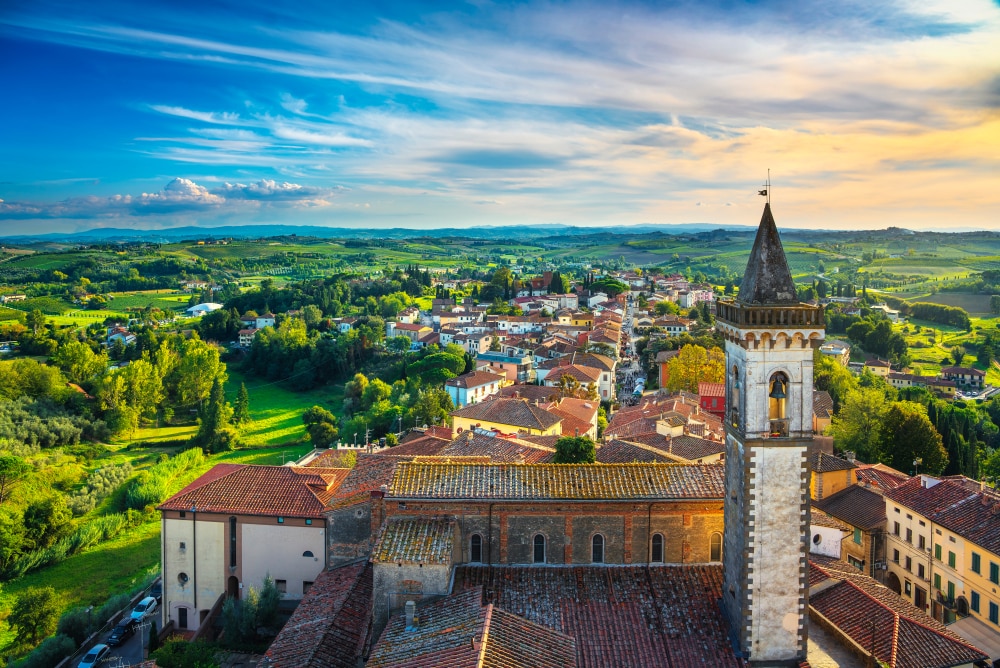
Vinci Village, Tuscany – Photo credit: Shutterstock – StevanZZ
It was on Saturday April 15, in 1452, that the young Leonardo di ser Piero da Vinci breathed his first breath, around the third hour of the night (around 1:30 am). If it has long been believed that the young Italian was born in Anchiano, it finally seems that it was in Vinci, a pretty town in Tuscany , that he was born.
Surnames:
In the 15th century, having a surname was still uncommon, and reserved for “big” families, such as the Medici. It is estimated that originally, the Medici family was to be composed of several doctors, hence their surname. For the others, the first name is generally followed by one or more “useful” details: a nickname, the name of his master for a craftsman, the name of his father, or that of his native town.
If Leonardo’s early years proved complicated, it was because he was the fruit of an illegitimate union. His father, Ser Piero da Vinci, 25, is a recognized notary and married. His mother, Caterina di Meo Lippi is a 15-year-old teenager from the peasant world.
First strolled between his mother and his paternal grandfather, the young artist finally joined his father’s house at the age of 5. Although the latter assumes in the eyes of all the paternity of the young “Leo”, the child will never be officially legitimized.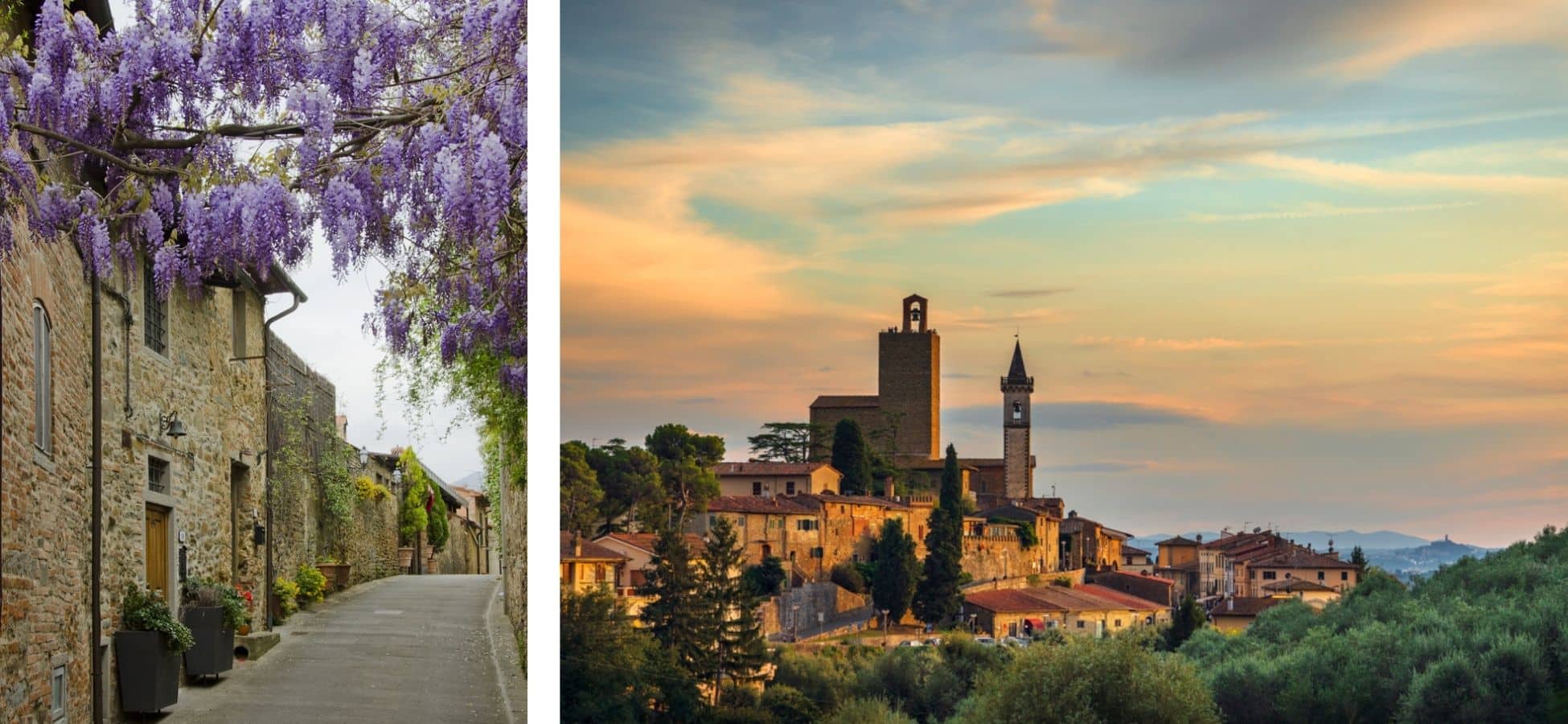
Village of Vinci and its alleys, Tuscany – Photo credit: Shutterstock – PhotoTrippingAmerica & StevanZZ
Leonardo da Vinci received an education similar to that of other children of his age. Walking through the pretty streets of Vinci and meeting the young boys of today, you can easily imagine him marveling at the beauty of his village. And how not to be amazed?
With its bell tower overlooking the narrow streets, the medieval-looking buildings, and the splendid view of the vines stretching as far as the horizon, Vinci seems to be an ode to “Italian” charm. Lost in the middle of Tuscany, the village is as if suspended, frozen in time. Here you will find the serenity you need to recharge your batteries. Feel the freshness of the long Tuscan plains mingle with the smell of the vines, struck by the sun. Admire the architecture so specific to this wonderful region of Italy, and take the opportunity to free your mind, to clear your mind…
For his part, Leonardo da Vinci does not immediately stand out from his comrades. He painfully learns the rudiments of reading, writing and arithmetic. Pupil of an establishment considered as “non-literate”, he learned neither Latin nor Greek. It is only once an adult, at the dawn of his forty years, that “Leo” will impose this apprenticeship on himself.
However, he already stands out for his attraction to art, probably fueled by his paternal grandmother, Lucia di ser Piero di Zoso, an accomplished ceramist. His drawings and paintings also caught the eye of his father, who then fell in love with a question, which would prove decisive: could Leonardo become an artist?
Florence , the decisive formation
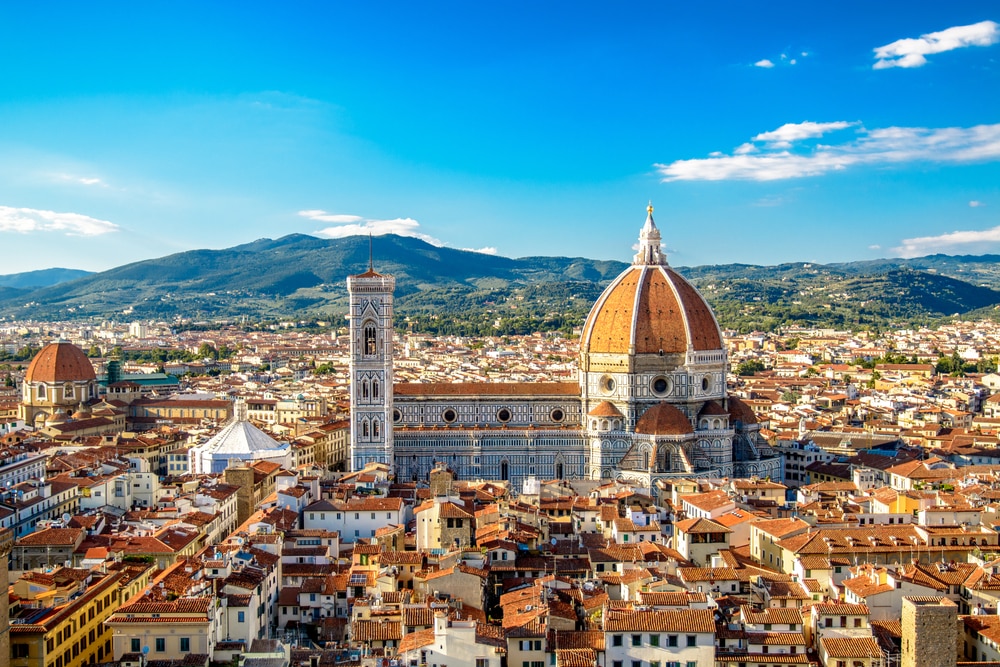
Florence and its Santa Maria del Fiore duomo – Photo credit: Shutterstock – kozer
It was at the age of 12, in 1464, that Leonardo da Vinci’s life took a completely different turn: he was accepted into Verrochio’s studio in Florence. More than accepted, moreover, he is summoned to go there, by Andrea del Verrochio himself. And the father of the young artist is no stranger to it.
Having fallen in love with his son’s sketches, Ser Piero da Vinci decided to take some of them with him to Florence. His goal is simple: show the drawings to his friend, Andrea del Verrochio. The latter, impressed by the talent of the young boy, immediately insisted that “Leo” join his studio as soon as possible. Thus, and even if he is listed as a resident of Vinci until 1468, Leonardo settled most of his time in Florence, where his father worked.
In Florence, the young “Leo” grew up, both professionally and personally. The bustle and bustle of this populous city fascinates, intrigues and excites him. He who had hitherto known only his small village of Vinci then discovered a world of celebration, joy and extravagance. Through his master, Verrochio, he also learned to rub shoulders with the greatest, even going so far as to approach the great Medici family.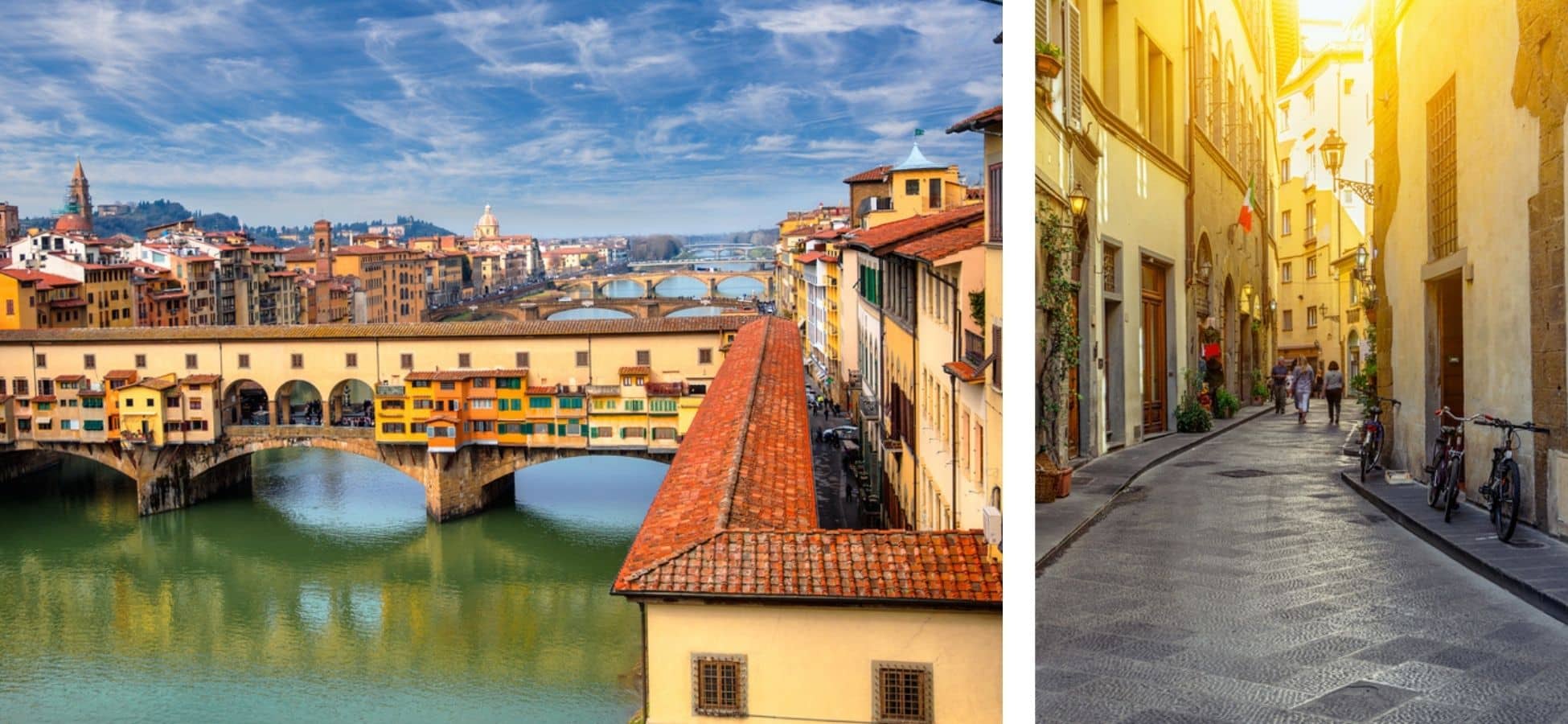
Florence and its Ponte Vecchio – Photo credit: Shutterstock – muratart & Catarina Belova
Today, the tumults of Florentine life have calmed down, giving way to romance. Florence, “La Bella”, is a sweetness. She is a whisper, a caress. An openness to culture and history. An enchanting and enchanting parenthesis that seems to open its arms to you, like Morpheus, to offer you a moment of peace and absolute serenity. Finally Florence, the capital of the Renaissance, has never been better named.
Treat yourself to a golden getaway, and imagine walking in the footsteps of the very young “Leo”, discovering turmoil and decadence. Stroll through the sun-drenched alleys along the banks of the Arno, or devote a day to discovering the many museums present in the city. If the capital of Tuscany conditions the life of Leonardo da Vinci, it is also the one that will mark your stay in Italy.
Leonardo, moreover, learned there both chemistry and metallurgy, painting and sculpture, on bronze as on marble, working with leather, plaster… A largely extensive teaching.
Time in prison:
Italian court records show that in 1476 Leonardo da Vinci was in prison. Indeed, the latter had been accused of sodomy, a practice considered illegal at the time in Florence. Although he was not sentenced, probably thanks to the support of Lorenzo de Medici, the Italian genius will have spent two months in prison, awaiting his judgment.
It was therefore in Florence, with his mentor Verrochio, that Leonardo da Vinci became an accomplished artist. But it was during his years in Milan that he developed his attraction for engineering and architecture.
The Milanese years

Milan and its cathedral – Photo credit: Shutterstock – Boris Stroujko
After fifteen years spent in Florence, alongside Verrocchio and the Medici family, it is time for Leonardo to evolve. Thus, the Florentine decides to put his suitcases in Milan , and to offer his services to another great Italian family: the Sforzas.
A letter written by Leonardo da Vinci even appears in the Codex Atlanticus. The latter is intended for Duke Ludovico Sforza, in order to convince him of his great engineering talents, and the wonders they could accomplish together.
The Codex Atlanticus:
The Codex Atlanticus is the largest collection of drawings, sketches and notes by Leonardo da Vinci. It has more than 1,120 pages, ranging from simple drawings to the first sketches of his great inventions.
Since 2019, you can go to the codex-atlanticus.it site , and view all the sheets.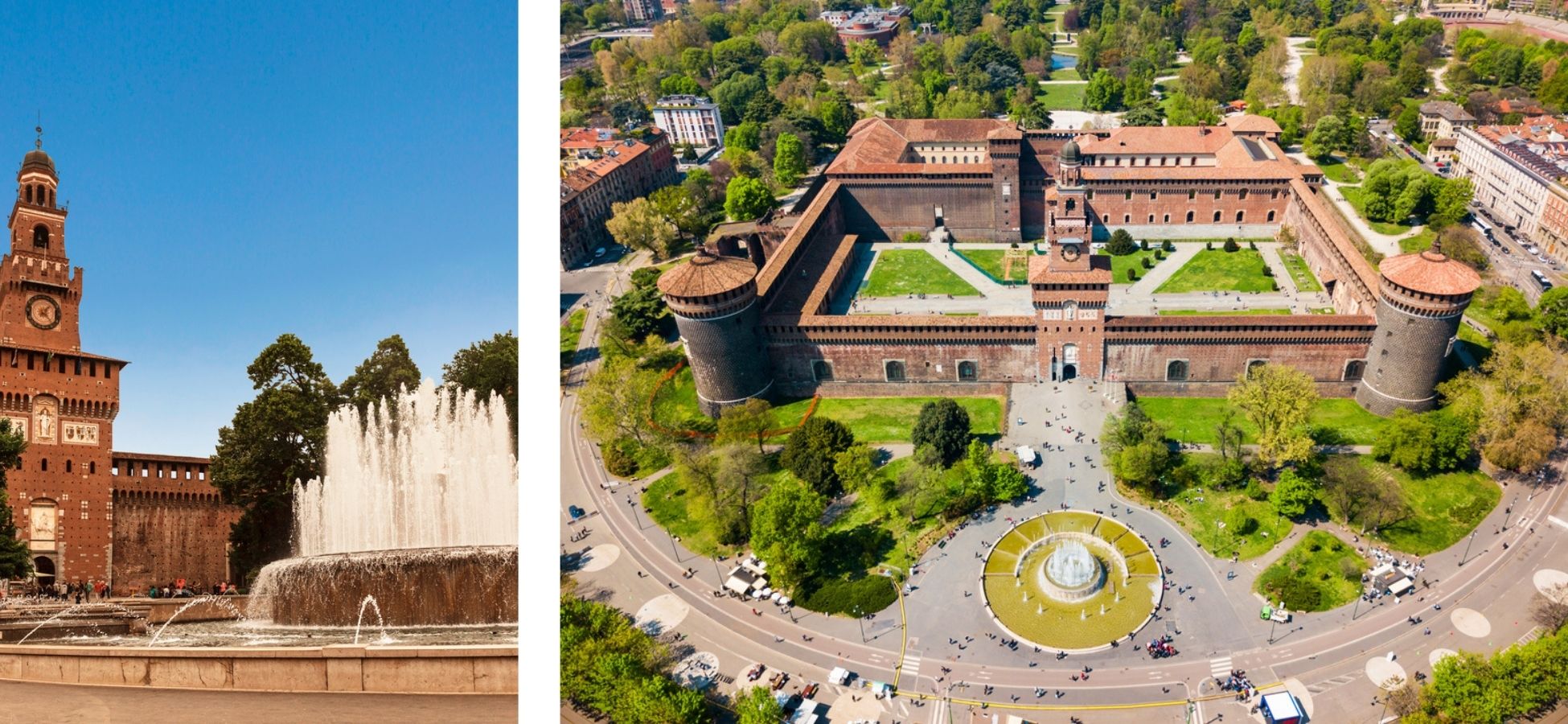
Sforza family castle, Milan – Photo credit: Shutterstock – volkova natalia & saiko3p
In view of the many talents that Leonardo da Vinci possessed, the duke did not hesitate for long. Thus, the artist joins the Sforza castle, and finds himself employed for various tasks. Officially, “Léo” becomes “organizer of parties and shows with sumptuous decorations”. Its role is simple: to organize the biggest parties ever known in Italy, and to invent theatrical machines that will amaze the public.
But Leonardo da Vinci also took advantage of his Milanese adventure to paint many portraits of important court figures, at the request of Ludovico Sforza. Every day, his fame grows, and he finally becomes “engineer in the service of the Sforza”, the consecration.
If you are passing through Milan, take the time to visit the Sforza Castle, considered at the time to be a marvel never seen before. It must be said that its construction dates from 1368! Several cultural museums are located in the heart of the building. But of course, Milan does not stop at this simple visit…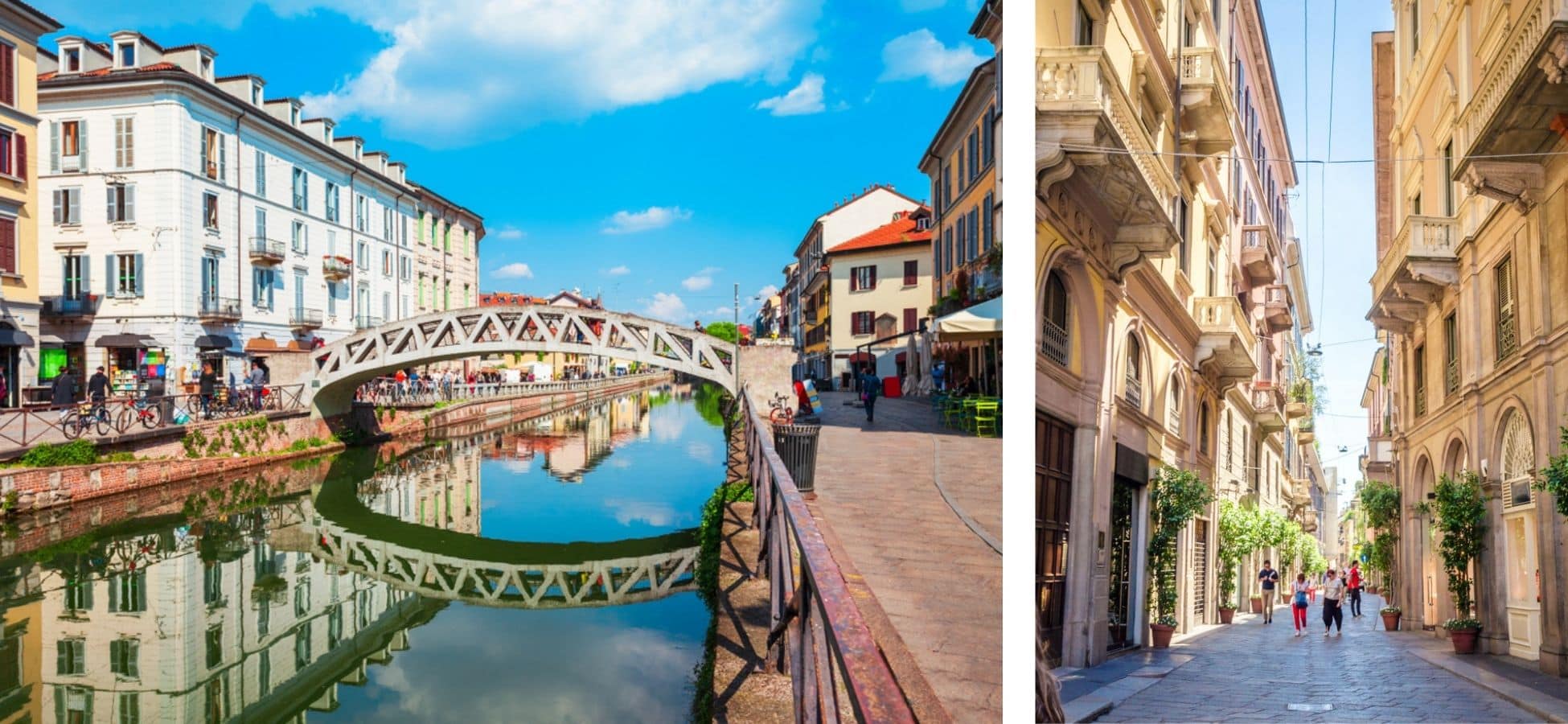
Canal Naviglio Grande, and narrow streets of downtown Milan – Photo credit: Shutterstock – saiko3p & Olena Z
If you have already traveled across Europe without ever setting foot in Milan, you must remedy this at all costs. Because the Lombard capital could be associated with a melting pot of different European capitals.
Take the architecture and access to culture of Paris , add the chill atmosphere and the pretty walks of Amsterdam , sprinkle in the sun and the relaxation of Barcelona , and you’ve reached the goal. Milan is, by far, the largest European “almost-capital”!
One of his marvels, Milan Cathedral, was one of the most important engineering files of da Vinci’s career. Indeed, his fame being growing, he was invited to the congress of architects and engineers aiming to complete the project of the Duomo of Milan , in 1490.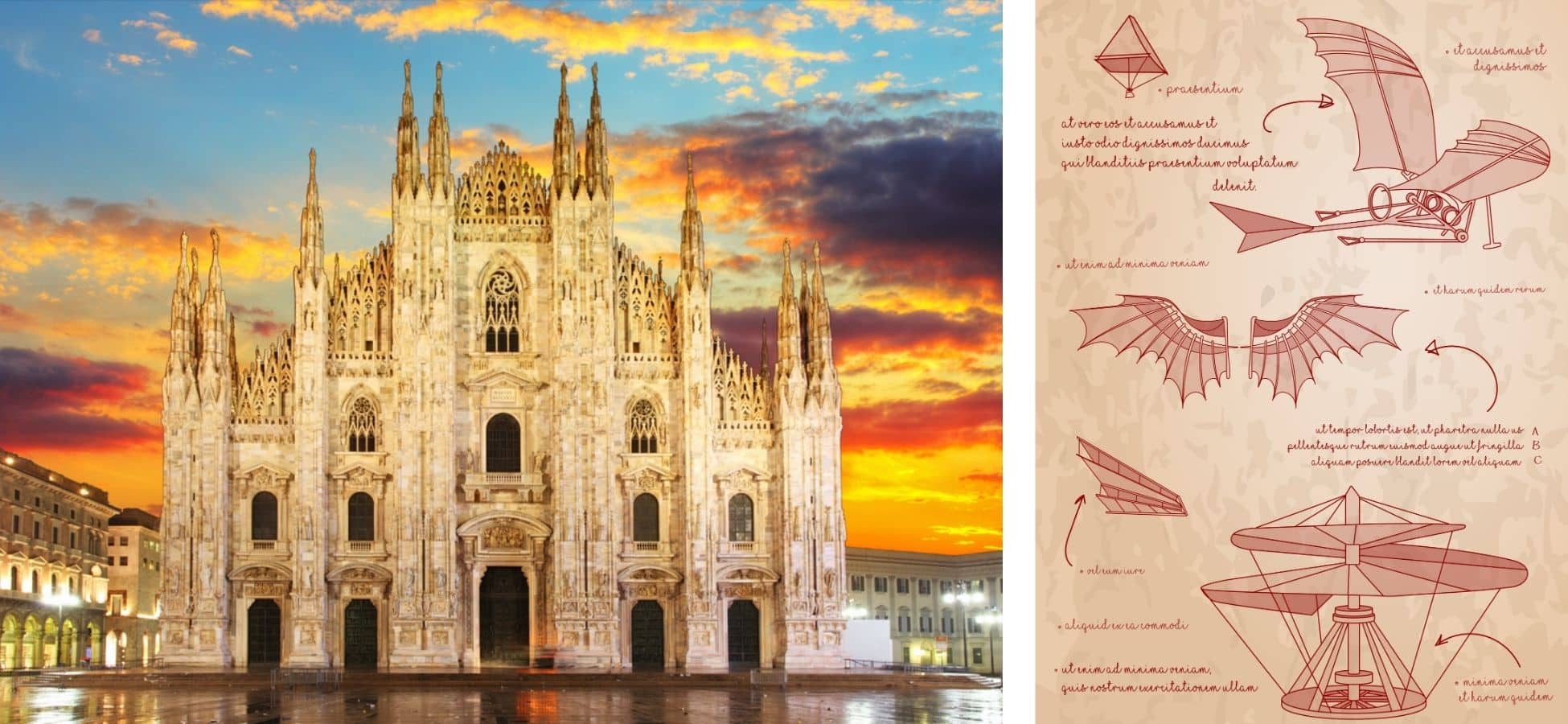
Milan Duomo on the left, Drawing by Leonardo da Vinci conceptualizing a flying machine on the right – Photo credit: Shutterstock – TTstudio & Kwirry
Besides this project, this Milanese period proved to be decisive in Leonardo’s career. The latter learns to diversify, beginning to use all of his talent. Clocks, cranes, looms, and even the first sketches of flying objects were born and/or improved thanks to the spirit of Italian genius.
In 1499, the troops of Louis XII of France took control of the Milanese City, and dismissed Duke Ludovico Sforza. Fearing, rightly, for his future, Leonardo da Vinci took refuge initially in Venice, before traveling through Italy. This reversal of the situation marks the beginning of the last fifteen Italian years of “Léo”, which will prove to be the most successful of his career.
Leonardo, at the top of his game
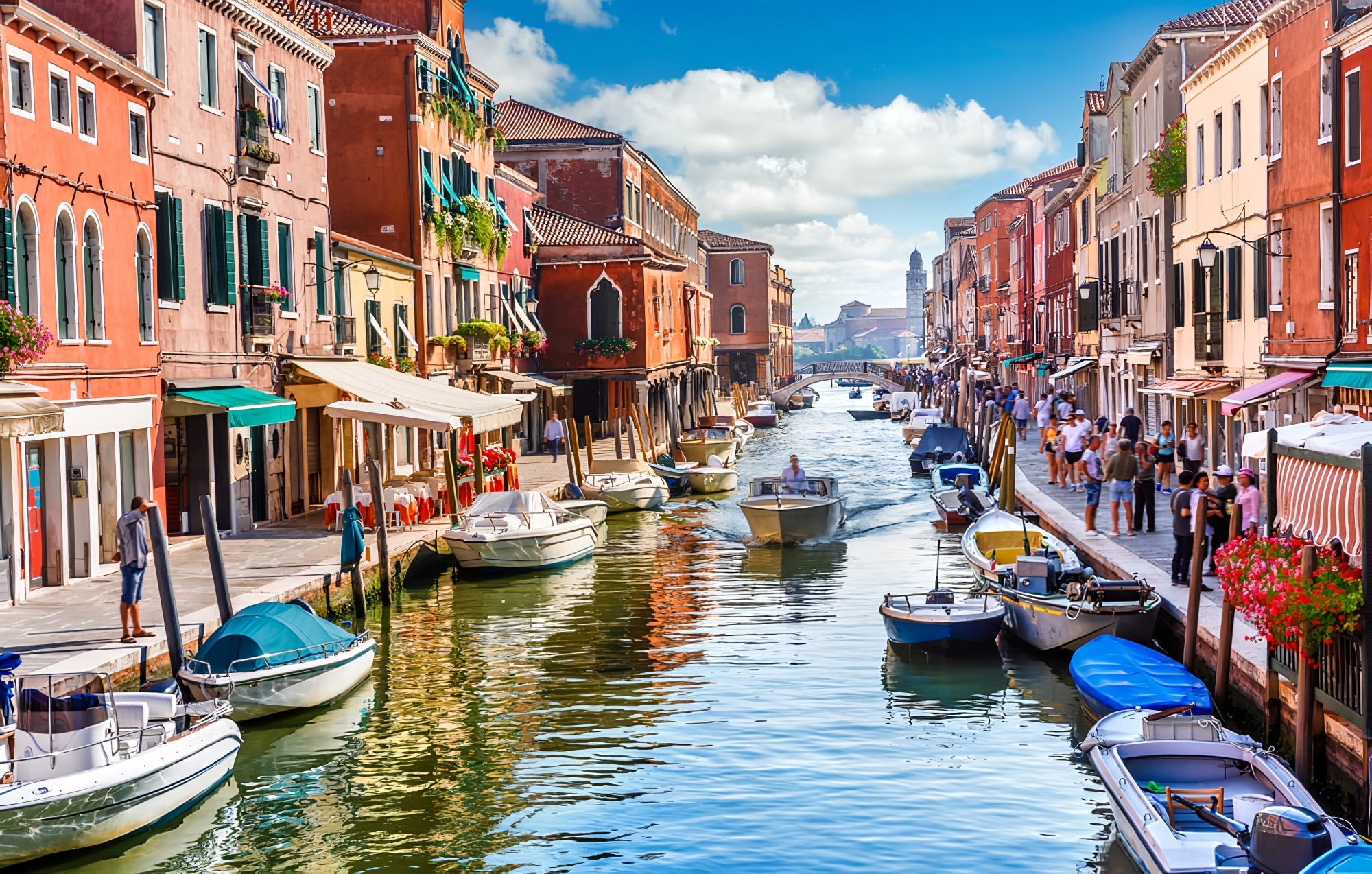
View of a street in Venice and its canals, Italy – Photo credit: Shutterstock – Yasonya
Military engineer then hydraulics, inventor then scientist, Léonard accumulates the activities with the wire of the cities which it crosses. In Venice , first, he presented his invention of the helmeted diving suit, which was much too elaborate for his congeners of the time. He proposes, at the same time, a heavy project of deviation of the Arno in order to connect the city of Florence to the sea. Although this project never sees the light of day, it highlights the oversized intellectual capacities of Leonardo, almost too ahead of its time.
In Venice, Leonardo da Vinci does not stay more than two months. And we wonder why. Here, it is not only romance that hovers, but life itself. The walls are colored, pink for some, yellow for others. They even give off such a special smell when the sun warms them up. The latter mingles with the soft melody of the wind caressing the flowers scattered on the balconies, and your senses are all in turmoil.
In the center you can admire and visit the Basilica di San Marco , Venetian architectural treasure. Obviously, the mythical canals that cross the city from side to side, crossed by equally colorful boats and gondolas, add an atmosphere of “eternity” to the city. A paradise on earth.
On the left, Basilica di San Marco – On the right, rue de Venise – Photo credit: Shutterstock – givaga & Vishnevetskiy
But not that of Leonardo, who first made the choice to oscillate between Florence, Milan and Rome , in order to offer his military inventions, which are becoming more and more numerous. Mortars, catapults, ten-headed cannons, movable bridges and even tanks were born from the mind of da Vinci.
But in the end, Leonardo quickly returns “to the source”, and puts his suitcases in Florence. Probably driven by the gentleness of the city, he began writing his “treatise on painting” there. Indeed, despite the extent of his talent and his possibilities, the art of painting remains by far the one he prefers. His ambition is then to record all the know-how and skills deemed necessary for the realization of the perfect work. More than simple technical advice, Leonardo da Vinci began thinking about and experimenting with the beauty of the world.
Too creative, or too attentive to the world around him, his mind wanders. Quickly, he understands that this treaty will never fit in a single book. So he began writing a treatise on anatomy, then on optics. He then launches into a treatise on shadow and light, on color, atmosphere, water, plants, but also on the movement of animals.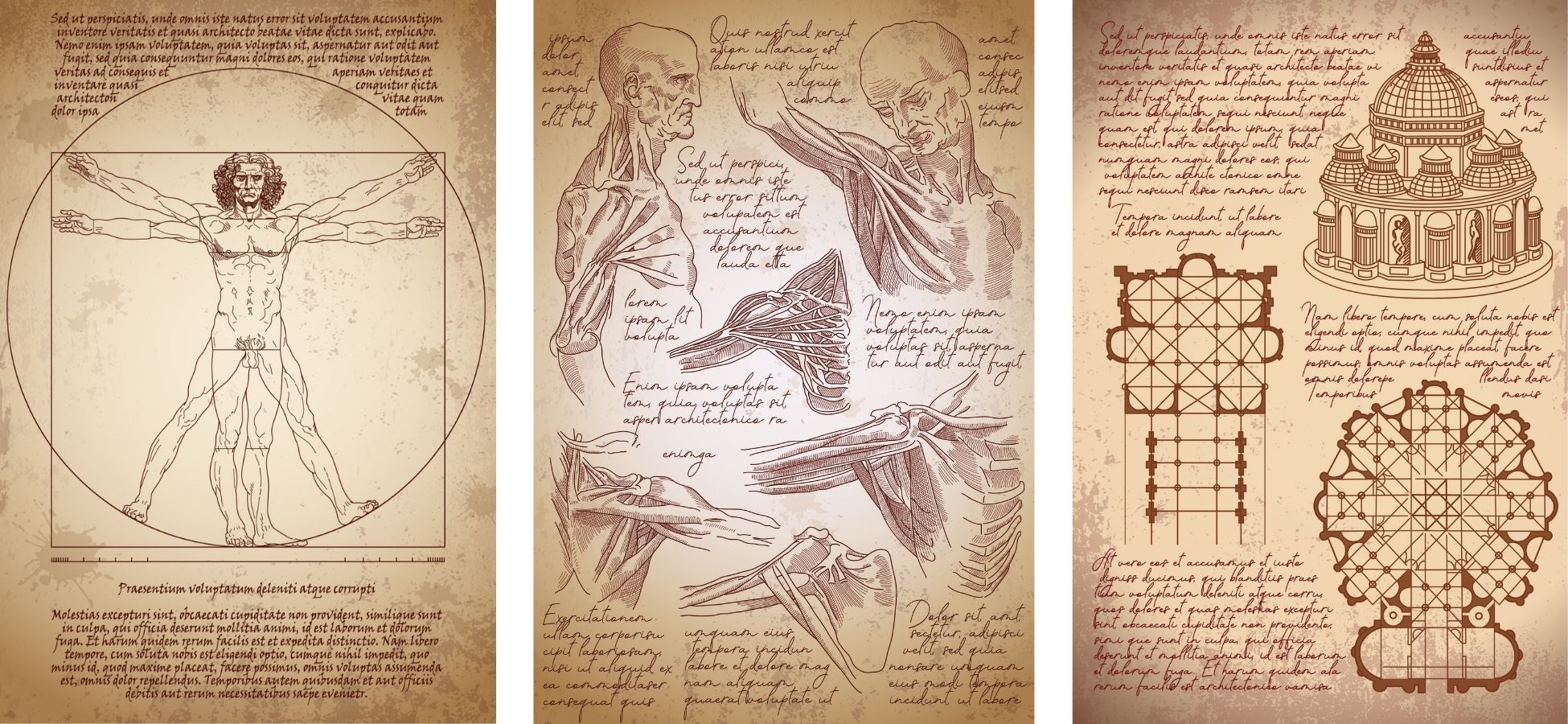
Various sketches by Leonardo da Vinci, including the Vitruvian Man, left – Photo credit: Shutterstock – Kwirry
This colossal project, Leonardo da Vinci will never come to an end. Today, it is estimated that more than half of his writings have disappeared. Nevertheless, there remain just over 6,000 sheets retracing the experiences of his creative genius. On one of them, we can read the following quote:
“The terrestrial body is an ocean, which increases and decreases every 6 hours, with the breathing of the universe. The flesh of the Earth is the soil, its bones are the rocks that form the mountains. The ocean fills the body of the earth with an infinity of watery veins. Man and the world offer a great analogy. »
Finally, after many journeys in the heart of Italy, having earned him his most beautiful pictorial works (“The Mona Lisa”, “The Virgin, the Child Jesus with Saint Anne and Saint John the Baptist”), Leonardo da Vinci settled in Rome. He joins a family that has given him so much, that of the Medici. But aged 61, the genius inventor finds himself overtaken by young artists, named Raphael and Michelangelo.
Colosseum and St. Peter’s Cathedral, Rome – Photo credit: Shutterstock – Catarina Belova & RomanSlavik.com
“The Medicis created me, the Medicis destroyed me” he ended up writing in one of his notebooks. A strong thought, which shows the disappointment of Leonardo’s stay in Rome. He, whose bubbling spirit convinces himself of never having had a site worthy of his qualities. A brilliant mind, but showing some difficulty in completing the work begun. A spirit that is too creative, too attentive to the world, perhaps too far ahead of its time.
In 1516, it was in France that Leonardo da Vinci came to end his days. The new King of France, François I, invites him to stay in the territory by giving him the Château du Clos Lucé with these words “Here Léonard, you will be free to dream, to think and to work”
The legend of the underground
François I, new king of France, is fascinated by Leonardo da Vinci, 22 years his senior. Some even lend themselves to saying that he considers him a mentor, almost like a father. According to the legend, the castle of Clos Lucé and that of Amboise (that of the king) join thanks to underground passages, allowing the young king to visit Leonardo as often as he wished, to take advice.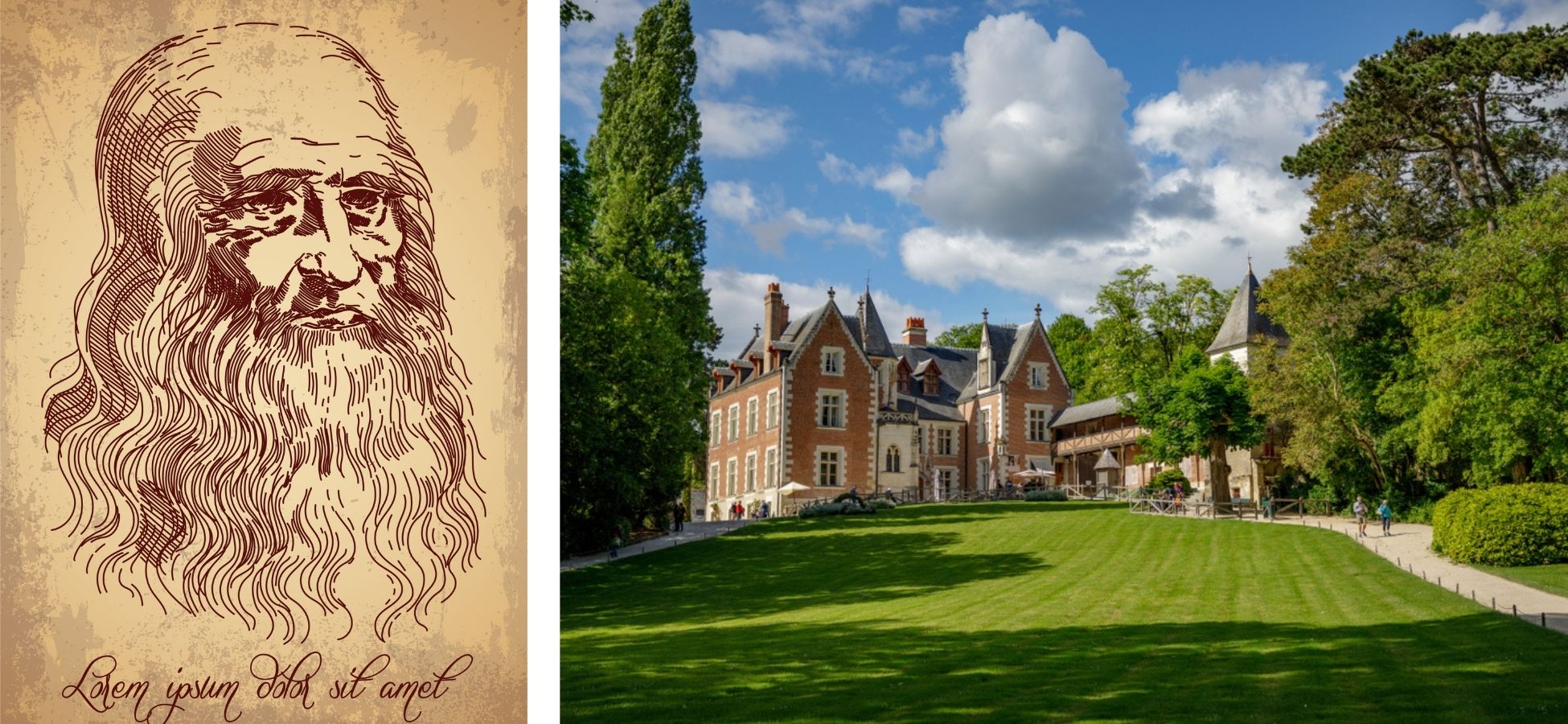
Last self-portrait of Leonardo da Vinci & Château du Clos Lucé – Photo credit: Shutterstock – Kwirry & Antonello Aringhieri
On May 2, 1519, after surviving several cardiovascular accidents, Leonardo da Vinci died of illness.
A soul, a spirit, a personality like the world had never known had just passed away. But his works, his desires and his creations still endure today, and will never die.
“As a busy day gives us good sleep, so a life well lived leads to a peaceful death. – Leonardo da Vinci
Did you like this article? Do not hesitate to share it on social networks and subscribe to Discover the World on Google News to not miss any articles!